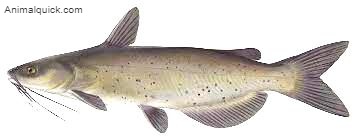Have you ever thought:
- Are Catfish Bottom Feeders?
- How Long Do Bottom Feeder Catfish Live?
- How Do You Tell If a Fish is a Bottom Feeder?
Short: No, catfish aren’t bottom feeders.
They eat various things and can swim at different levels in the water, not just at the bottom.
Are Catfish Bottom Feeders?
Yes, catfish are bottom feeders.
They have special mouths and whisker-like barbels that help them search for food at the bottom of the water.
They eat all sorts of stuff, like bugs, plants, and whatever else they can find.
They’re not picky eaters! These catfish are important because they help keep the water clean.
Some catfish, like bullheads, stick mostly to the bottom, while others, like channels and blues, might venture up a bit higher in the water.
But overall, catfish are the bottom-feeders of freshwater areas, with their special mouths and whiskers helping them out.
How Long Do Bottom Feeder Catfish Live?
Bottom-feeder catfish can live a pretty long time, especially when they have good living conditions.
– Regular catfish like channel and blue catfish usually live around 15-20 years on average. If everything’s perfect—lots of food and a comfortable home—they might even live for 30 years or more.
– Smaller catfish, like bullheads and madtoms, usually hang around for 5-7 years. They don’t typically go beyond 10 years.
– The big catfish, like blue catfish and flathead catfish, can be real champs in the age department. Some of them might even reach 40-50 years. There’s a famous blue catfish caught in 2011 that could have been 30-50 years old!
– Even in aquariums with super clean water and great care, some catfish have hit the 30+ years mark.
Is Catfish a Healthy Bottom-Feeder?
Yes, Catfish is a healthy bottom feeder.
Here is Why:
- Lean Protein: Catfish is a great source of lean protein, with just around 3 grams of fat per serving. It’s a healthier option compared to fattier fish like salmon.
- Heart-Healthy Fats: The fats in catfish are mostly the good kind—monounsaturated and polyunsaturated omega-3 fatty acids. These fats can reduce inflammation and support heart health.
- Essential Nutrients: Catfish is packed with important nutrients like niacin, vitamin B12, selenium, and phosphorus. Plus, you get a good dose of vitamin D and B vitamins like riboflavin.
- Low Mercury Levels: Unlike larger predatory fish, catfish have low mercury levels. They’re not high up the food chain, so they’re a safer choice for regular consumption.
What Do Bottom Feeders Eat?
Bottom feeders eat in variations such as insects, larvae, other fish, and aquatic plants.
- Insects and Larvae: They go for things like mayfly nymphs, aquatic worms, midge larvae, and water fleas – basically, small bugs.
- Crustaceans: Scavenging amphipods, crayfish, shrimp, and other crustaceans are often on the menu for these bottom feeders.
- Mollusks: They snack on small freshwater clams, snails, and mussels.
- Aquatic Plants and Algae: Some bottom feeders like to graze on plant material and algae they find in the mud and sediments.
- Detritus and Debris: They’re not picky – decaying organic matter like dead fish, rotting plants, feathers, and waste particles is a major food source.
- Leftover Fish Food or Prey: Anything that sinks after being uneaten is fair game.
- Other Fish: Sometimes, they’ll even go after smaller fish that share their feeding grounds.
How Do You Tell If a Fish is a Bottom Feeder?
You can identify whether a fish is a bottom feeder or not by looking at their mouth position, barbels, body shape, habitat preference, and feeding behavior.
- Mouth Position: Bottom feeders have mouths that point downward toward the bottom, allowing them to dig into the substrate. This is different from midwater swimmers whose mouths are typically forward or upward.
- Barbels: Many bottom feeders have sensory barbels or “whiskers” around their mouths. These barbels help them find food in murky or silty conditions where visibility is poor.
- Body Shape: Bottom feeders often have flattened ventral surfaces or downward-sloped heads, making it easier for them to rest near the bottom. This characteristic is seen in certain catfish, stingrays, gobies, and sole/flounder species.
- Habitat Preference: Bottom feeders prefer soft, muddy, or rocky bottoms in their habitats.
- Feeding Behavior: Watch for behaviors like rooting through bottom sediments, overturning stones in search of prey, or waiting motionless to ambush passing prey. These actions indicate that the fish primarily get their food from the bottom.
What Bottom Feeder Fish to Avoid?
Being mindful of the types of bottom-feeder fish you consume is important for your health.
Some bottom-feeder fish that are best to avoid eating:
- Carp: Carp are bottom-feeding fish that often live in polluted waters. They can accumulate industrial toxins like PCBs and have high parasite loads, which could pose health risks.
- Catfish from Polluted Waters: While catfish are generally safe to eat, those caught in contaminated lakes, rivers, or downstream industrial areas may accumulate heavy metals like mercury or other toxins in their fatty tissues.
- Imported Asian Catfish: Imported frozen catfish from overseas may have less oversight and standards in their production. This could lead to issues such as antibiotic residues and contamination.
- King Mackerel: This popular game fish is prone to high mercury absorption as it ages and grows larger. The risk of toxin accumulation is greater with adult king mackerel.
- Tilefish: Similar to king mackerel, large tilefish found in deep ocean areas can accumulate high levels of mercury in their meat due to pollution. It’s best to avoid them.
Read More:
- Rohu Fish Benefits and Side Effects
- Why is Basa Fish Banned?
- Are Fish Reptiles?
- Can Catfish Make Noise?
- Can Catfish and Goldfish Live Together?
FAQs
Is a guppy a bottom feeder?
No, a guppy is not a bottom feeder.
Is ROHU a bottom feeder?
No, ROHU is not a bottom feeder.
Are salmon bottom feeders?
Salmon are not bottom feeders; they are predatory fish that primarily eat other smaller fish.
Are smelt bottom feeders?
Yes, smelt are bottom feeders that primarily feed on small aquatic organisms found at the bottom of freshwater bodies.
Are bottom feeders bad for you?
Bottom feeders are not inherently bad for you, as they can provide a valuable source of nutrients and omega-3 fatty acids when consumed in moderation.
What Catfish is Not a Bottom Feeder?
Catfish is not a bottom feeder as it mainly feeds on aquatic insects, small fish, and crayfish.

I love animals & want to know more about different creatures & sharing their stories with everyone. From my childhood, I’ve been exploring forests & watching animals in their homes.
Now, I write about my adventures & all the amazing things I learned. My blogs are easy to understand & make you want to know more about animals. I teach about why animals are important & why we should take care of them.

